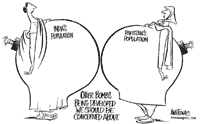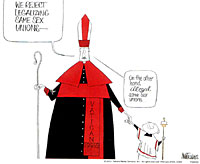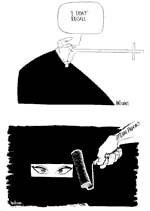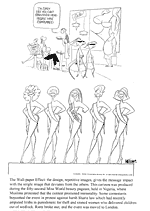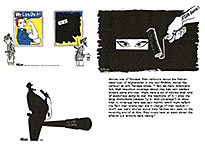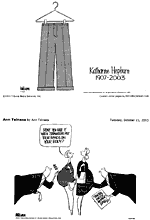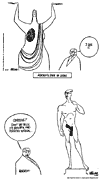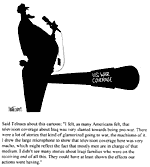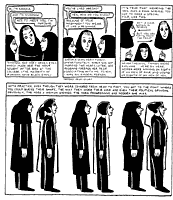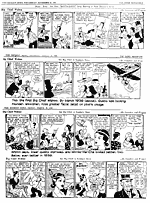 |
|||||||||
|
Opus 149: Opus
149 ( NOUS R Not All the
News, Just the News That Gives Us Fits At Pawnee, Harvey Pekar's forthcoming autobiographical
graphic novel is titled The Quitter
because, Pekar explained to Glenn Lovell at the San Jose Mercury News, "I quit at
things because I can't stand the tension of waiting to see if I'm successful
at something. I quit sports in school. I quit college. I even quit the
post office because I worried I wouldn't be able to bundle up the envelopes
tight enough that they wouldn't break apart." Lovell elaborates:
"Pekar remains our pre-eminent practitioner of woe-is-me-ism. You
name the accolade or accomplishment, and Pekar will find its downside."
Ostensibly famous, now, after the movie adaptation of his story "American
Splendor," Pekar says he is nonetheless "waiting for the other
shoe to drop: I've always gotten good reviews, but my work has never
sold very well." He's signed a deal with Random House to do four
paperbacks, but he's not hopeful of financial success. "If they're
fairly well received," he said, "I'll be able to barely get
by. If not, I'm faced with the prospect of working at McDonald's. I
don't have very many salable skills." Pekar and Robert Crumb, the
artist who first rendered the schlub hero's adventures in comics form,
are "a match made in hangdog heaven," Lovell says in a phrase
too memorable to let slip by (so here it is). I've
never understood "The Simpsons."
I watched it a couple times when it first appeared and everyone
was raving about it; I didn't think it was all that funny. The show
is now the longest-running primetime animated series in history-and
the longest-running sitcom currently on the air. Something's wrong with
me, I realize, but now in my dotage, I'm too old to change. Perhaps
I should buy Chris Turner's new book, Planet
Simpson: How A Cartoon Masterpiece Documented An Era and Defined A Generation
(Random House)-reportedly (according to Ben Rayner at the Toronto Star) "an entertaining, episodic examination of the Simpsons
phenomenon from various socio-cultural, historical and theoretical angles."
Turner concedes that nothing destroys humor of something like a discussion
of what makes it funny, "so he took care to keep Planet Simpson as lively and irreverent
as possible while still holding it up to serious, intellectual study,"
Rayner said. "Thus, while there is much novel theorizing about
'The Simpsons' influence on the development of Internet culture and
the show's place at the epicenter of an explosion in American satire
that now includes such disparate offspring as 'South Park,' The
Onion and 'The Daily Show,' there are also plenty of amusing, capsulated
asides [and memorable moments recounted] providing much opportunity
for a pastime most beloved by the show's fans-Remembering Simpsons."
Rayner, himself an unreconstructed fan of the show, concludes with this
cosmic assessment: "To its adherents, 'The Simpsons' has transcended
its humble beginnings as an 'adult cartoon' to become an almost religious
fixture in our lives. To many, in fact, 'The Simpsons' is-if I may borrow
from John Lennon and the B-Sharps-'bigger than Jesus.' Ignorance of
the show and its impact is almost like ignorance of Christianity; you
don't have to buy into it, but you should probably try to understand
what it is everyone's crowing about." So Planet Simpson is for me, I guess. If not
that, then one or more of the titles in HarperCollins new series, Simpsons
Library of Wisdom. This month, the first two volumes will sally forth:
The Bart Book and The Homer Book, joining over 30 other Simpsons books in print. The Bart Book will share the kid's School
Survival Guide, secret codes, pullable pranks, dream tattoos, favorite
El Barto "tags," and the Xmas list to end all lists (it sez
here). With a bountiful cast of characters, the book possibilities seem,
as they say, endless. I'm still lost. I don't like "King of the
Hill" either. Jules Feiffer's new play, "A Bad
Friend," is a semi-autobiographical fable based upon the cartoonist-playwright's
pre-fame life in the early 1950s. Interviewed by Jane Horwitz at the
Washington Post, Feiffer said:
"When I got out of the Army in 1953, I fell into the company of
a number of young Brooklyn artists. ... All of us were left wing."
Among them was a middle-aged painter "who attached himself to us.
... He turned out to be Rudolf Ivanovich Abel, the most important Russian
spy ever caught in this country. So years afterwards, I thought I have
to ... describe what it was like ... as a young man in your twenties
to feel like you know everything and it turns out you know nothing."
The play is critical of the House Un-American Activities Committee's
witch hunts for commies, but it also ridicules fellow travelers who
remained convinced that Joseph Stalin was a good guy. Surprisingly,
Feiffer reported, many of his friends and acquaintances of this stamp
told him they approved of the play. "It seems to have been, at
least for these people, the first time they saw a version of themselves
that they recognized, as opposed to a stereotype. I was bowled over."
The play opened in Washington October 30 and will run through November
28. Strippery. In Greg Evans' Luann, the title
character said farewell to the love of her young life during the week
of October 25: handsome Aaron Hill, with whom Luann has been smitten
ever since he showed up years ago, moved with his family to Hawaii,
but before he left, he took Luann to dinner, and when he took her home,
he kissed her. Adolescent dreams were never so fondly, heart-warmingly,
enacted. When I asked Evans whether this event would inaugurate a long-distance
romance, he wrote back: "Lots of readers have taken me to task
for sending Aaron away. They cite my reader poll a few years back in
which I asked who Luann should go to the Prom with, Aaron or Gunther.
Aaron won (by a slim margin) and so readers expected a Luann/Aaron romance.
But as we in the writing business know, happy hookups don't yield good
drama-or comedy (witness Li'l Abner, "Moonlighting," "Friends,"
etc.). The best relationships are the ones we never quite have. So will
there be a long distance romance? I can tell you with absolute certainty-maybe."
... And in Stone Soup, cartoonist Jan Eliot started a "book club"
which she populated with female characters from other comic strips-
Connie Duncan from Zits, Ellie
Patterson from For Better or For
Worse, Dilbert's cubicle mate with the pyramid hair-do, and Rose
from Rose Is Rose (who, when they discuss books
they want to read suggests Lady
Chatterly's Lover and is transformed, forthwith, into Vicki the
Biker). Nicely done. And Eliot expertly captures the appearances of
all these distaff characters without copying them, hair by hair. A treat. Berke Breathed is always quotable these
days (after years of being a rigid recluse). Interviewed on the occasion
of the publication of Little Brown & Company's new compilation,
Opus: 25 Years of His Sunday Best, a collection
of the cartoonist's favorite strips from Bloom County, Outland, and, lately, Opus, Breathed was confronted with the "fuzzy math" of a
anniversary book that is published one year too soon: Bloom County started in 1980. "Buy the book January 1 of next
year," Breathed said, "if these things bother you, and sleep
at night with a safe 25 years. Listen," he went on, "Bush
has raised the bar with getting comfortable with fuzzy everything. On
his terms, I should have been able to call this the Centennial
Opus Collection." About his current endeavor, Opus every weekend, Breathed admitted that "a Sunday-only strip
is not actually a comic strip in most any sense. Four cartoons a month
rather than 30 is something else. Something less, I fear. But I hope
that it's more than nothing. This is exactly how our government rationalized
the current war. The wrong war is better than, well, no war. Bush told
me this in an e-mail." And Finally: Boris Yefimov may be the
oldest practicing cartoonist on the planet: he was 104 on September
28, and he still draws every day-albeit just for personal pleasure,
not for a living. Although not a willing instrument of the Communist
state in Stalin's Russia, Yefimov survived by his talent, dutifully
creating caricatures that ridiculed Soviet foes from the Bolshevik Revolution
to Mikhail Gorbachev's "perestroika." He helped sustain the
morale of frontline Russian troops during World War II with pictures
of Hitler as a crazed zealot, and during the ensuing Cold War, he depicted
the U.S. as a mean-looking Uncle Sam, bristling with missiles and dollar
signs. Yefimov had little choice: Stalin gave him orders, and Stalin
crushed those who disobeyed. Yefimov's brother, editor of the Party's
newspaper, Pravda, was arrested
in 1938 and tortured and executed at the age of 40. Yefimov has a picture
of his brother on the wall of his riverside apartment in Moscow. "It
may be superstition," he told Richard Balmforth of Reuters, "but
I think that somewhere, in the place where the fate of people is decided,
those years that were taken from him were passed on to me." The Laudable
Tenacity of Telnaes: Raw Indignation in Symphonic Line The first words Ann Telnaes said to me were: "I
think I love you." This memorable (to me-she's forgotten it entirely)
moment occurred in June 1998, three years before she earned a Pulitzer
Prize for editorial cartooning. She had been editooning for about six
years by then, but I had just encountered her work and, noticing an
e-mail address under her signature, I'd written to say that I was delighted
to see such hard-hitting cartoons as hers, drawn in a style markedly
different from the usual run-of-the-mill. "I think I love you,"
she responded, but, popping the rising balloon of romance immediately,
she continued: "Tell your wife this is not a come-on: it's just
that I'm so sick of editorial cartoonists and syndicate people who seem
to have forgotten editorial cartoons should have a point." And
so, alas, my fling crashed and burned at take-off. Just as well: I'm
of a vintage to qualify as her father, and these December-May romances
never last. (Well, December doesn't.) I mention all this mushy stuff
in order to establish two things before telling you about Telnaes' new
book of cartoons. First, I am a friend of the cartoonist; second, my
friendship was preceded by a fervent admiration for her work. And that
admiration has survived the friendship and continues, unabated, growing
more profound with each new cartoon. Humor's Edge: Cartoons by Ann Telnaes (144
8x8-inch pages in hardback; Pomegranate, $24.95) is, like Telnaes and
her cartoons, an elegant production: her drawings, which appear on the
Web (www.anntelnaes.com) with
sparkling accents of color, are reproduced here on sumptuous glossy
paper with those same accents plus annotations that provide the political
context for the cartoons. The book's title and its contents are taken
from a recent (June-August 2004) exhibit of her work at the Library
of Congress, and her interview by Harry Katz, Head Curator of the Library's
Popular and Graphic Art Division, is the chief text feature of the book.
In
the book's introduction, fellow editoonist Ben
Sargent of the Austin American-Statesman, writes about Telnaes'
impact: "There's no better word," he writes, "to sum
up the cumulative effect of the perceptive analysis, bold imagery, trenchant
wit, and tireless indignation that make up a Telnaes cartoon. ... It
might be easy to call her proudly liberal, but her indignation is kindled
by any variety of injustice, oppression, hypocrisy, or sham, from whatever
quarter. While she's deployed much of her best venom against affronts
to women's rights and civil liberties, she's had plenty left for the
vast array of other corruptions, plots, and idiocies that seem so depressingly
endemic in public life." As
for her drawings, "they are unique," Sargent says, "-in
their grace, simplicity, and power of line, probably a reflection of
Ann's early career as an animator and graphic illustrator. And she's
a master of the cartoon virtue called 'economy of line' -every single
element in a Telnaes cartoon helps to draw the readers eye and mind
to the message." Syndicated to newspapers throughout the country by Tribune Media Services, Telnaes has no home paper and works out of her private D.C. domicile (which she shares with her husband, David Lloyd, a Washington legal talent). Without an editor at her elbow, she suffers no "prior restraint" in expressing her opinions however she chooses. Her cartoons are simply put "out there"; and if an editor somewhere objects to what she says, he doesn't publish the cartoons that say it. So Telnaes plunges ahead, full speed, pennants flying and trumpets blaring. She trained in animation and spent six years in Disney's Imagineering division, and her distinctive style evokes images of Disney and Warner Brothers animated cartoons. But the fluid lyricism of her line suggests that famed theatrical caricaturist Al Hirschfeld was an influence. Not so, Telnaes explains. She admires Hirschfeld, but she studied and was influenced by Ronald Searle, Robert Osborn, and Gerald Scarfe. She also admired Herblock, for his art and for his fierce expression of opinion, thoughtfully arrived at. While she is especially exercised about hypocrisy and the abuse of power wherever she finds manifestations of either, Telnaes is notably ferocious on issues affecting women, and she sees those issues where others are overlooking them. When the news media were frothing a few years ago about Pakistan and India both having developed the atomic bomb, Telnaes remembered a report about the two countries being in the top five in population by 2020. "Where will they put all those people?" she wondered. And so she drew a cartoon depicting two pregnant women facing each other, their protruding bellies abstracted into round bomblike shapes with fuses protruding on one side. One belly is labeled "Pakistan's Population"; the other, "India's Population." And the cartoon's caption reads: "Other bombs being developed we should be concerned about." Picture and words blend to evoke the familiar expression about the "population explosion." "Women's
issues on the whole are not reported enough," Telnaes said during
a Washington Post "Live Online"
discussion last winter. "Just look at your front page-how many
front page stories are about women? Women make up more than half of
the U.S. population so it's not a special interest. Everyone should
be concerned about issues that affect women because everyone has a mother,
a sister, a wife, a girlfriend, a daughter." To dramatize the inadequacy
of news coverage of women's concerns, Telnaes cited the situation in
Afghanistan: "Everyone now is familiar with Afghanistan when the
Taliban ruled. This wasn't something that just came out of September
11. This started back in 1996 when the Taliban took control and established
rules which put women at an extreme disadvantage. They weren't allowed
to work, go to school, get medical attention, because the Taliban wouldn't
allow women to be seen by men, and all the doctors were men, of course,
since women weren't allowed to work. Can you imagine our government
ignoring, for so many years, a regime which curtailed men's rights to
that extreme?" Telnaes
passionately opposes the current tendency to meld church and state into
a political juggernaut. "Anything having to do with abuse of power
motivates me," she told Katz. "That goes for politics and
religion, as well as organized religion. I've done a lot of things about
the Vatican and its influence throughout the world because it affects
so many women that aren't even Catholics in terms of family planning.
Or the recent scandal about sexual abuse of boys we had here in the
United States-I did a lot of cartoons about that. That's a difficult
issue because some people take cartoons like that to mean you're criticizing
Catholics in general." When
the Vatican denounced same-sex marriages in July 2003, Telnaes spotted
the hypocrisy inherent in an i The
power of Telnaes' streamlined drawings is enhanced by the strong sense
of design by which she organizes her images. Her deployment of shapes,
positive and negative space, color, and stark white and solid black
give her art an impact not on display as consistently in any other editorial
cartooning of our day. Sometimes the design itself is the message. When
Cardinal Bernard Law in Boston answered questions about the molestation
of young boys in churches under his wing, he responded, usually, "I
don't recall." Telnaes drew the Cardinal uttering this legalistic
bromide, depicting him from the waist up, a vast expanse of solid black
clerical garb from the collar down, which, at the left of the picture,
threw into sharp relief her rendering of his nose, elongated in the
best Pinocchio tradition, ending in the shape of a cross in a vast white
space to the right. Contrasted against the mass of solid black on the
left, the white half of the picture-the part with the long nose-is emphasized.
And when Telnaes commented upon the Taliban's rise to power in Afghanistan
in 1996, she cried out against the enveloping burka and the subjugation
of women it represented by drawing a black solid in the center of which
a woman's eyes can be seen peering out from a white rectangle. She has
since employed this device several times in commenting on the treatment
of women in the Muslim world. Telnaes
is also a brilliant caricaturist. She credits lessons she took while
attending the California Institute of the Arts, but, just between thee
and me, lessons hone talent they do not create it. She loves to caricature.
"I find that a successful caricature has more to do with how much
you know the person than what he looks like," she told me once.
"I hate doing caricatures from still photos. I like to see a person
on video or tv or in person-because I feel that's a way you get to know
them." The
world of editorial cartooning is dominated by male view points: there
are fewer than a half-dozen full-time women editorial cartoonists. I'm
everlastingly overjoyed that one of them is Ann Telnaes, whose work
is so stunningly executed and so unflinchingly outspoken on issues so
frequently overlooked. And you'll see what I mean in this great little
volume. Here's a gallery of her work, some from the book, some from
my files, including a couple of my all-time favorite Telnaes cartoons.
(One was done when Katherine Hepburn died; it shows a pair of slacks
on a hanger. Brilliant.)
Funnybook Fan
Fare The two-issue mini-series (with only two issues, a minuscule
mini-series) Harry Johnson takes
a trip into a venue I've often hoped someone would visit-light-hearted
adventure with a liberal dose of sexual shenanigans. The title character
is a private detective of the Sam Spade sort with a snap-brim hat and
a broken nose and five-o'clock shadow, and he has a beauteous damsel
for a client and an equally fetching stripper for a traveling companion
when he takes the case that takes him to South America. The character
designs are by Dean Yeagle, an animator and illustrator whose toothsome femmes appear,
from time to memorable time, in the pages of Playboy. (Yeagle has lately produced two tasty paperback collections
of his pin-up chicks, Scribblings
and Scribblings 2, which prove,
without quibble, that he is a master at limning pertly cute young sexpots,
all sporting zaftig embonpoint of the softest most enticing sort. For
more, see www.cagedbeagle.com.) Yeagle's
designs are expertly translated into pencil renditions by Craig Rousseau and inked by Norman
Lee, serving a confection by Charles
Fulp (of Fulp Fiction, at a website of the same name); colors by
Liquid elevate the visuals to yet another highly burnished realm of
excellence. The story, which employs Nazi villains and a mildly crazed
captive scientist (who has developed a serum for making super soldiers
that works, so far, only on women by increasing the size of their bosoms)
as well as a femme fatale in leather and a chorus line of Nazi girl
soldiers, is a trifle, and it is loaded with double entendre and silly
juvenile jokes, many of which spring from the names of the characters,
beginning with the hero. I first encountered "johnson" as
slang for the male sexual apparatus when visiting t-shirt shops years
ago on Myrtle Beach, where every t-shirt seemed just another pun of
the same ilk. In the comic books at hand, we are quickly initiated into
this region of the infantiley risque when the shapely Selena Crabbe,
wearing a bright red, skin-tight strapless gown, enters the detective's
office and says, "I'm looking for a Harry Johnson." To which
our hero reposits: "Shouldn't be hard to find one in a dress like
that." The name of the stripper is Fanny Sellers. They journey,
after a stop in South America, to India, where they acquire a "native"
assistant whose name is Dhalabil Phut. His first name is pronounced,
Harry concludes, "dollar bill," so Harry decides to call him
"Buck" for short. "But," says Fanny, "that
would make his name ... " Mercifully, she doesn't finish the sentence.
The Nazi general's name is Butplugge, which, he tells us, is pronounced
"boot ploog" but which Harry translates into "butt plug."
Most of the humor and sexual innuendo is of this adolescent kind, but
the pictures and the storytelling-breakdowns and layout-are skillfully
managed. I suppose this may be as close as I get to good, light-hearted
adventure with similarly light-hearted sexual content. Not bad at all;
but not superlative either (except the pictures). Understanding
the Axis of Evil About a year ago, Marjane Satrapi, an Iranian woman
in exile, created a stir in the publishing world with her first book,
entitled Persepolis, an autobiographical account
of her childhood in Iran, growing to adolescence under the totalitarian
regime of the Islamic revolution. It was the form of her narrative as
much as its subject that captured the enthusiasm of book critics: Satrapi
told her story in the form of a graphic novel (hence, the more appropriate
term "graphic memoir" to designate a work of non-fiction).
At the time, Satrapi was living in France, a virtually unknown young
would-be painter hoping to be a children's book author. Like
Art Spiegelman's Maus (which
inspired her), Satrapi's work persuasively demonstrated that the visual-verbal
narrative could be deployed for serious subjects, and suddenly, like
Spiegelman, Satrapi was a famous personage, being interviewed hither
and yon by critics and reporters, all frothing over her achievement.
Now 34, Satrapi, abetted by her fame as a cartoonist, has published
two children's books and the sequel to her first endeavor, Persepolis
2 (192 6x9-inch pages; hardcover, $17.95). The title, which means
"city of Persians," is a symptom of the author's nonconformist
stance, evoking, as it does, the ancient culture of Satrapi's native
country by way of reminding her readers that Iran is not synonymous
with the hostage-taking of 1979-80 or with the repressive rule of the
mullahs since then or with the menace the Bush League sees in the present
Iranian government. Her
hope, Satrapi explained in an interview with Bitch magazine last year, is that her books will "put a face
on this 'axis of evil'" and thereby persuade people that behind
that abstract expression there are genuine human beings, individuals,
with lives and stories, loves and losses, like people everywhere. Said
she: "If I have one goal, it is to show that this drastic division
of the world into West and East is complete nonsense. If people can
read my story and they can identify with me and imagine that this could
happen to them, then I have done the biggest part of the thing that
I wanted to do, which is to convince people that I am not different.
I am not scary-we are very much alike. I try to understand you [in the
West], so please try to understand me." Like
any artist, however, Satrapi has motives that arise from a creative
impulse rather than a political or even humanitarian one. Interviewed
in the lobby of her hotel when she visited the U.S. promoting her second
opus, she complained about how difficult it is in American hotels for
cigarette smokers like her. When her interviewer suggested that the
rules against smoking were intended to promote good health, Satrapi
replied tartly: "If they had to forbid everything that's bad for
the health they shouldn't permit lots of things." Her
questioning dissidence has informed her life and, therefore, her art.
The first Persepolis begins
in 1980, the year the mullahs began requiring women to wear the veil.
Satrapi is ten years old, a rather typical smart and spirited youngster
who, as she grows to the age of fourteen, encounters the oppressive
pressures of the extremist theocracy and, with the mischievousness of
youthful exuberance, resists living "under the veil." At the
end of the book, her parents, middle-class secular liberals who value
their daughter's independent thinking, send her away to complete her
education in Vienna, where, they believe, she will be safe from the
Islamic fundamentalism that smothers intellectual and pyschological
growth. Persepolis 2 reveals that her escape is
illusory. Because she is in a foreign environment, she finds herself
as much a misfit in Austria as she was in Iran. First living in a convent,
she is evicted by the nuns because she rebels against their rules. She
then takes up with hippies and lives in a house with several gay men.
Her first romantic relationship ends badly when she discovers her boyfriend
in bed with another girl, and when, on the heels of this discovery,
her landlady wrongly accuses her of theft, she takes to the streets,
sleeping in streetcars and finding food in trash cans for two months
until she collapses and awakens in a hospital. Although
the book is subtitled "The Story of a Return," her homelessness
in Austria is a better metaphor for the life the book rehearses. She
spends four years in Vienna-her adolescent years, the most trying time
of growing up, when teenagers search for identity. And she tries several
identities (including drug dealing), but she is conducting her search
as an outsider in a culture hostile to the beliefs of her upbringing.
Instead of assuring her safety, her parents unwittingly condemned her
to soul-destroying isolation. Homesick when she leaves the hospital,
she returns to Iran. There,
she continues to search for herself, and homesickness takes on a contrary
shade of meaning as she grows increasingly sick of this home: her experience
of freedom in Europe makes the oppression and sexism of her homeland
harder to endure than ever. Although the girlfriends of her childhood
dress like American tv actresses, they are deeply imbued with Islamic
traditions, and when Satrapi reveals that she has slept with a man without
being married to him, they call her a whore. She is as much a misfit
in Iran as she was in Austria. She tries suicide but fails. Concluding
that she was not meant to die, she undertakes a cosmetic make-over and
becomes an aerobic instructor. She meets the man she will marry, and
they attend the University of Tehran together as art students, but they
prove completely incompatible, and she divorces him and leaves Iran.
At a tearful family parting, her mother tells her, "This time,
you are leaving for good. You are a free woman. The Iran of today is
not for you. I forbid you to come back." Satrapi returns to Europe.
The
book is not a feminist tract, Satrapi insists. "The men [of Iran]
are not in much better situation that we are," she said; "they
go to jail also. ...We suffer on different things, but in the artistic
way, the female and the male are equal-everybody suffers. Anybody who
[makes an] attempt toward freedom suffers." Her
self-portrait is unflinching: Satrapi is scarcely a heroic protagonist.
Once while back in Iran, she runs into the morality police while wearing
lipstick. Desperate to avoid arrest for this violation, she distracts
them by going to them and pointing to a man nearby, a person wholly
unknown to her, who, she says, has said something indecent to her. They
arrest him and ignore her lipstick. Later in the book, Satrapi laughs
about it and never quite redeems herself for this mean and selfish act.
Despite its uncomplimentary nature, she believes it was necessary to
include the incident to show the repression and paranoia in Iran. "Fear
pushed me to do it," she explains. "I was so scared of being
caught by these people. By creating an atmosphere of complete paranoia,
they are able to manipulate so easily a whole population. ... When you
are scared, you don't think anymore." In an interview with Vanessa
Jones of the Boston Globe,
Satrapi elaborated on the circumstance, relating it to America under
the Bush League, which has "scared people so much that they've
lost any sense of criticism." Satrapi's
black-and-white naif drawing style, evocative, sometimes, of Matisse,
seems too simple for the depressing realism of her story. But she drenches
many panels in solid black, masking the almost complete lack of visual
detail while also giving the story a suitably somber aura. And the simplicity
of her style permits her to capture the emotions of her characters with
just a few lines, often adding comic relief to an episode with revealing
facial expressions. Working in black and white is more difficult, she
believes. "You cannot cheat when you make artwork in black and
white," she said: "you make a lousy drawing, [and] you put
some color on it, and it looks nice. With black and white, if it's lousy,
everyone will see it." For
an artist who likes to write, the graphic novel form as a creative vehicle
was, to Satrapi, "absolutely obvious. ... When I read Maus, I saw that it was possible to talk about a war in the comic
format. I have always been drawing, and I think that pictures have,
once in a while, power that words don't have. I have always [made] narrative
illustrations, so after a while, making comics became like making evidence
for me." Questions about the appropriateness of the form to the
subject are, to her, irrelevant: "No one would ever ask a writer
why he wrote a book and didn't make a movie," she said. Asked
about the possible limits of the graphic novel form-particularly whether
certain emotions like the homesickness and the profound sense of displacement
of her book's first part can be adequately portrayed in visual-verbal
terms-Satrapi suggests that if this is a shortcoming in her work, it
is due to her own limits as an artist and writer, not the inadequacy
of the form. Said she: "Maybe I haven't been successful. That is
one thing. But saying that the graphic novel is not able to do that
is absolutely false because there are so many graphic novels that talk
about internal feelings." While
much of her story is told with a simple progression of uniform-sized
panels, she varies this routine for dramatic emphasis, deploying the
resources of her medium effectively to enhance the significance of a
sequence. Sometimes, Satrapi's pictures are purely diagrammatic; sometimes,
symbolic-both visual maneuvers that the simplicity of her style permits
her to indulge readily without being stylistically intrusive, both adding
dimensions of meaning to her narrative. She provides a vivid diagrammatic
shorthand explaining he In
the New York Times, Luc Sante
wrote: "Satrapi's voice is as artfully artless as her graphic style,
never giving any indication of effort or calculation but simply communicating,
in a way that feels unmediated, like a letter from a friend ... honest,
strong-willed, funny, tender, impulsive, self-aware." Satrapi
says she doesn't think of herself as a cultural ambassador, but that
is what she has become with her books. "If you leave your country,
it's because life there is unbearable," she said, "and you
have to quit. But it doesn't mean that after you arrive [in a new place],
your life is very easy. It's very hard because you have to assimilate
a new culture. You come from somewhere where you have been someone,
and you become no one. Everyone looks down on you. You don't have any
more culture because you have to forget your own in order to assimilate
a new one. I was not an Iranian, I was not a European-I was nobody." Now
living in France where she has lived for some years, Satrapi says, "If
I were a man, I might say that Iran is my mother, and France is my wife.
My mother, whether she's crazy or not, I would die for her. No matter
what, she is my mother. She is me, and I am her. My wife I can cheat
on with another woman, I can leave her, I can also love her and make
her children. But it's not like that with my mother." When
she started her book in 1999, "I didn't know that the situation
of the world would be such that my book would be really important to
read," she says. "At that time, I thought I was just making
a book of memory." But today, her book, she hopes, will show that
Iran's 70 million people are human beings, "not just an abstract
notion." In this spirit, she concludes: "If tomorrow we are
going to be the next target [in the war on terrorism], it is not the
government that is going to pay; it is the people, the civilians." She
has two more graphic novels in preparation: Embroidery
is based upon a long afternoon in hker late grandmother's house
during which several ladies sit and talk about sex; in The Chicken and the Plum, her great uncle, a musician in the fifties,
recounts his long life during his last eight days. End of a Long,
Strange Winding Trail One of the last adventure strips in captivity will expire
at year's end: on Sunday, December 26, Steve Roper and Mike Nomad ends after 68 years. The strip changed
its name more times than any other (save one) -five. Nancy was once Fritzi Ritz;
just two names. Popeye
was once Thimble Theatre. Only Snuffy Smith equals the Roper/Nomad enterprise for alternating
titles. Snuffy Smith was once
Barney Google and Snuffy Smith, and before
that, it was Barney Google and
Spark Plug, a modification of its simpler predecessor, Barney Google; but it began as
Take Barney Google, F'instance. Every name change signals a shift
in the popularity of a character in the strip. Following his career
nurturing a race horse named Spark Plug, Barney loitered for a decade
in the foothills and was then replaced by the hillbilly lay-about Snuffy
and his moonshining brethren. Fritzi surrendered her spotlight to her
niece, Nancy. Popeye, once he wandered onto the stage at Thimble Theatre,
got all the applause. Some
haphazard histories of Steve Roper
and Mike Nomad suggest that the strip started out as The Great Gusto. Yes and no. That was, indeed, the first name for
the strip, but a strip with that name was never syndicated. In 1935
in Toledo, Ohio, Allen Saunders
had given up, temporarily, his quest to become a syndicated cartoonist.
He'd tried a one-panel feature, Miserable
Moments, patterned after Clare
Briggs' When A Feller Needs A Friend, but that
went nowhere, so he continued his newspaper career as drama critic for
the Toledo News-Bee. Across the street at the
Toledo Blade, its art editor,
Elmer Woggon, had also tried, unsuccessfully,
to get himself syndicated as a cartoonist. "He had created the
first aviation strip, Skylark,"
Saunders wrote, "which failed to get off the ground, I suspect,
because its creator had never been in a plane." Another reason
may have been a jarring contradiction inherent in Woggon's approach:
he drew in a bigfoot comedic manner, but he tried to show how airplanes
actually work, an endeavor that would have been more appealing if pictured
realistically. But he had another idea-a gag strip about an old-time
medicine show impresario and con-man named J. Mortimer Gusto, "The
Great Gusto," who was to be accompanied, as many of his ilk were,
by a "shill" to work the crowds, in this case, a pint-sized
Indian in a giant sombrero named Wahoo. Gusto was modeled after vaudeville
comedian and thirties movie-star W.C. Fields (who would rather be in
Philadelphia than dead). Others in the ensemble included a beauteous
Indian maiden, Minnie-Ha-Cha, a tot named Pigtails, and the horse that
dragged Gusto's wagon around, Ammonia. Despite the stellar line-up,
Woggon felt somehow inadequate to tell their story, so he enlisted Saunders,
who, he knew, had been selling detective fiction to the pulps. In those
days, apparently one kind of writer was as good as any other kind so
Woggon quite naturally supposed that if Saunders could write theater
criticism and detective fiction, he could write a humorous comic strip.
Saunders agreed. But their combined efforts in The
Great Gusto did not result in a strip that attracted subscribing
newspapers. Some editors, however, had expressed interest in the diminutive
Wahoo. Woggon and Saunders retooled their effort, making the little
big-nosed fellow the star and title character of their comical continuity
strip, now titled Big Chief Wahoo. In his new role, Wahoo
is "the richest Indian without a reservation" and sets out
for New York, where he hopes to reclaim his sweetheart, Minnie-Ha-Cha.
This incarnation sold. Gusto became the supporting character, who shows
up on the fourth day of the strip's run and encounters Wahoo en route
to the Big Apple. The
strip debuted November 25, 1936, and several amusing adventures ensued-Wahoo
as a backward native encountering civilization and Gusto as the bombastic
Fieldsian operator. The daily production of the strip was more than
Woggon could undertake alone, however, and before long, Wahoo had acquired a rather extensive "staff." As Saunders
put it: "It takes many more hands to draw a strip than to write
it, and Wog had added to our team his brother Bill, a former WPA artist
named Don Dean, and Paul McCarthy." But the strip's revenues did not support such
an extensi In
1939, Saunders was offered the writing chores on Apple Mary, a continuity strip about a street peddler and her "family."
Although he wasn't much attracted to the assignment, Saunders soon found
a way to heighten his interest. "Laboring over the continuity,"
he once wrote, "I chanced upon a happy idea one day. Instead of
treacly melodrama, why not do stories of the sort that were used in
popular magazines for women? " At a stroke, Saunders midwifed the
soap opera comic strip, and Apple Mary became Mary Worth. The success
of the remodeled strip doubtless prompted Saunders to take another look
at Wahoo. Surveying the average comics page
in the nation's newspapers, he realized that serious continuity strips
were more in evidence than humorous ones, and he decided to apply that
nostrum to Wahoo. He brought in a handsome heroic
character named Steve Roper, a freelance news photographer, and before
long, Wahoo was playing second fiddle to Roper. Serious storytelling
required more realistic visuals, and Woggon "stepped aside uncomplainingly
as a succession of such men took over his drawing board." The first
of these was Dean, who, by then, was up to the task. The strip's title
was changed a little to take the emphasis off bigfoot: starting in about
late 1939, it was Chief Wahoo, and it remained so until after
World War II. Woggon's association with the strip continued: he lettered
it until he died in 1977. "Don stayed with us until he sold a strip
of his own, Cranberry Boggs,
a New England version of Li'l
Abner," Saunders said.
Boggs was launched January 8, 1945; Dean may have continued drawing
Wahoo for a time, or perhaps
another (as yet unknown) artist took over. Shortly after World War II
ended, Pete Hoffman took
over the drawing. (He says "after the War," which would be
in the fall of 1945; but he may have been discharged earlier, assuming
the art chores as soon as Dean left.) Hoffman had enlisted in the Army
air corps shortly after Pearl Harbor, but he had met Saunders and Woggon
before then, as the cartoonist on the campus weekly newspaper at the
University of Toledo. By the time of his discharge from miliary service,
Hoffman said, Wahoo was in the last stages of its transition to serious adventure
storytelling, "and a more illustrative style of drawing was desired;
my style fit their needs." Completing the transition was the next
alteration of the strip's title: it was now Steve
Roper and Chief Wahoo. In 1947 or early 1948, Wahoo disappeared,
leaving Steve Roper alone on the marquee. Hoffman
stayed on the job until he sold his own strip, Jeff Cobb, about a crusading and adventure-prone newspaperman, which
was launched June 28, 1954, but he said he'd enjoyed "ghosting
[Roper and Wahoo] for nearly nine years." Jeff Cobb lasted 24 years, written and drawn by Hoffman, who delighted
in telling storytelling with a minimum of verbiage. Hoffman's successor
on Steve Roper was William Overgard, who had been drawing
comic books for Lev Gleason in the post-war years. He'd been trying
to get a syndicated gig, and when the Roper
job opened up, he was invited to compete with other candidates for
the assignment. "Fortunately," he wrote, "I managed to
scoot by and win, and that was the beginning of my career as a strip
cartoonist." Overgard was more than just an illustrator: over the
years, he wrote several television scenarios and a couple novels; my
impression is that his relationship with Saunders (and, subsequently,
with Saunders' son John, who took over his father's writing career)
was sometimes rocky, that he often did as much writing (or re-writing)
on the strip as drawing. Almost upon arrival, Overgard persuaded Saunders
to add a new cast member-a tough, Mickey Spillane sort of anti-hero
named Mike Nomad, "a realistic working-man kind of guy who was
not beyond taking any opportunity that presented itself," Overgard
said. "This type of hero hadn't really become popular at that time"
he added, but "I had been including [him] in some of the strip
submissions I had been sending to various syndicates without success."
Understandably, since Nomad was Overgard's conception, he probably tinkered
with Saunders' scripts if he didn't like the way the writer treated
the character. Nomad was soon center-stage, most of the stories engaging
him rather than Roper. Ironically, Nomad didn't show up in the title
of the strip until Overgard was about to leave. In early 1983, Overgard
launched an unusual humor strip: Rudy was about an eponymous talking ape,
a one-time vaudeville star, but despite its fantasy premise, it was
drawn in Overgard's realistic manner. Fran Matera took over Steve Roper and Mike Nomad in 1984. Matera's
career was as varied as the strip's title had been. He ghosted Kerry Drake for a year or so (1946); ditto
Little Annie Rooney (1951)
and Rex Morgan, M.D. (1976-78), Apartment 3-G, and Judge Parker. He had a byline when doing Dickie Dare (1947-48) and several other strips- Mr. Holiday (1950-52), Nero Wolfe (1957), Galexo (1974-75), The Legend of Bruce Lee (1982-83), and Chuck White and His Friends and Can
You Solve the Mystery, not to mention the occasional comic book
assignment. With
Steve Roper and Mike Nomad's departure
from the ranks of adventure strips, only 9 adventure strips remain among
the 17 storytelling strips: Alley
Oop, The Amazing Spider-Man, Annie, Dick Tracy, Brenda Starr, Mandrake
the Magician, The Phantom, Mark Trail, and, on Sunday only, Prince Valiant. (Two more, Tarzan
and Flash Gordon, are in re-runs.)
Of the 9, only 3 (Spider-Man,
Brenda Starr, and Mark Trail)
appeared after 1940; the adventure strip heyday, the 1930s, was clearly
over, and Roper and Nomad are among the last vestiges of a glorious
era in newspaper comics. The remaining storytelling strips are: Gil
Thorpe, Mary Worth, Rex Morgan, Judge Parker, Apartment 3-G, Funky Winkerbean,
For Better or For Worse, and Gasoline
Alley. Of the 17, only two (Funky
Winkerbean and FBOFW) are
still in the hands of their originators; the rest are legacy strips,
some better done than others. Under the Spreading
Punditry The election of George W. ("Whopper") Bush
is simply too catastrophic to contemplate yet. The pundits and pollsters
credit "moral values" for swinging the balloting to Dubya.
And he's a person of "moral values"? He lies, distorts, and
breaks or perverts the laws he's supposed to execute, but he's a champion
of "moral values"? Fine. "Moral values" is, I suspect,
a doublespeak for "Christian values." We're talking the political
usurpation of the government by the religious right. "Christian"
to them doesn't mean all Christians. It means only the Christians in
my church or denomination. Theirs is a curiously intolerant Christianity.
We agonize about "religious fundamentalists" taking over the
government in Afghanistan and/or Iraq when "religious fundamentalists"
have already assumed a throne in our own so-called form of government.
Yesterday
(November 4), George W. ("Warlord") Bush held a press conference
to announce that he was going to spend the "political capital"
of his "mandate" in repealing the 20th century.
The Little Old Lady in Dubuque who refused to vote was right when she
explained her civic dereliction by saying that voting only encourages
them. As
a measure either of the intensity of the Presidential race or of the
increased license allowed to comic strip cartooners, several comic strips
jumped in and commented on the Election Campaign. In the closing days
of the campaign, in Jeff Mallett's Frazz, the school staged a "mock election." The candidates
were Willy Wonka and Harry Potter. Said the school janitor Frazz: "But
those aren't real people. They're just characters manufactured to advance
a line of thought." To which the teacher says, "What's wrong
with that?" And Frazz responds: "It's too close to right."
In Bill Griffith's Zippy, the Lone Ranger rides up too late to save the country. And
in Darrin Bell's Candorville, the central character, a black
guy named Lemont, spent the rest of the week just trying to get to vote.
I'm sure there were other manifestations of political angst; I just
missed seeing 'em all. In the conservative mongering Mallard Fillmore, cartoonist Bruce Tinsley sought to beat the time
lapse predicament (the time between when he produces a strip and when
the strip is published, always in syndication too long an interval to
permit overnight response) by staging during the week before the Election
a sequence in which Kerry wins. So on Wednesday, the day after the Election
in real life, newsduck Mallard says: "Good evening. Our top story
is that this week's comic strips were drawn before the Election and
show John Kerry winning. If what's being reported here bears no resemblance
to actual events, you're probably used to it, if you watch much broadcast
news." A neat shot at the so-called "liberal media."
(So if the Republicans occupy the White House, influence a majority
on the Supreme Court, and control both houses of Congress, why are they
still complaining about being a minority persecuted by the "liberal
media"?) Meanwhile, in Bud
Grace's Piranha Club, Ralph Nader has won the Election
but is late to deliver his State of the Union address to Congress because
he missed his bus. Editorial
cartoonists, who haven't the time-lapse hurdle that confronts syndicated
comic strip cartoonists, can produce their reactions for tomorrow's
papers. Alarm and disgust prevailed among all but the conservative minority.
There are more liberal political cartoonists than conservative, but
the conservatively inclined are more numerous than I'd supposed. Recently
on the list serve of the Association of American Editorial Cartoonists,
the participants assembled a roster of conservatives that numbered 44.
Of those, only about 25 are full-time editorial cartoonists, but that
represents at least a quarter of the total full-timers in the country.
Not bad for a bunch claiming victimhood every chance they get. The New Yorker endorsed Kerry, mostly,
we gather from editor David Remnick's testimony to Charlie Rose on October
30, because it would disingenuous not to: the magazine has been faithfully
critical of GW all along, implying support of whoever his opponent might
be. In the published endorsement, however, Kerry's virtues were detailed
and applauded at the end of a long litany of all of Dubya's sins and
crimes of malfeasance. Yes,
I'm sorry Kerry didn't win: caricaturing him over the next four years
would be a lot more fun than caricaturing the front man for the Bushwah
Boys. On the other hand, it's a pleasure to compose poison-pen Bushwhacking
prose in honor of the current Halliburton House occupant. Four more
years of bungling and bumbling-who could ask for more? In the spirit of the next four years,
then-in the interest of championing moral turpitude in loyal opposition-here's
our discovery of the answer to a question that has plagued the human
sapiens (sic) for almost a century:
To find out about Harv's books, click here. |
|||||||||

send e-mail to R.C. Harvey Art of the Comic Book - Art of the Funnies - Accidental Ambassador Gordo - reviews - order form - Harv's Hindsights - main page |
